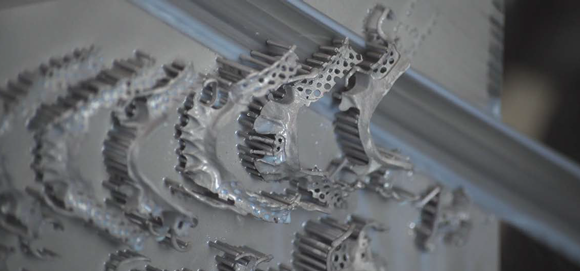Renishaw enables metal Additive Manufacturing of Removable Partial Dentures
April 15, 2019

Metal additively manufactured Removable Partial Dentures produced by Renishaw (Courtesy Renishaw plc)
Renishaw, Gloucestershire, UK, has collaborated with Egan Dental Laboratory, Yorkshire, UK, a specialist in chrome cobalt and prosthetics, to fully digitise the design and manufacture of Removable Partial Dentures (RPDs), also known as chromes. The move to digital techniques is said to have halved the time required to produce a chrome framework and resulted in the production of stronger, more accurate, yet thinner RPDs.
Egan Dental Laboratory was established in 2002, and collectively, its team has over seventy-five years of experience in the dental industry, supplying dentists with chrome frameworks, from one-tooth dentures to implant-supported prostheses. Being aware of the trend in crown and bridge dentistry towards a fully digital workflow, the company approached Renishaw to develop a robust Additive Manufacturing process for RPDs.
“We worked with Renishaw to develop an Additive Manufacturing process where every RPD produced is superb. We are now at a stage where every chrome framework is a perfect fit first time,” stated Gill Egan, Managing Director of Egan Dental Laboratory. Prior to working with Renishaw, the company was using traditional methods to manufacture and design its prostheses, such as the lost wax technique.
Using this manual process, it took technicians two hours to complete each cast chrome framework. Lost wax casting is also prone to error because, when casting metal by hand, the cobalt chrome material used in RPDs shrinks on cooling. The technician must make models based on this principle, using expansion liquid so that when the metal shrinks during casting, the resulting framework still fits.
An additional issue with casting by hand is that the denture is constrained by manufacturing limitations which make it difficult to achieve a thin cross section. Attempting to do so often results in the deformation of the prosthesis. Errors can also be introduced if the molten metal doesn’t enter the mould cleanly, causing frames to be incomplete, and there is also a risk of porosity if the molten metal is overheated, which can cause the introduction of excessive carbon – leading to structural weaknesses.
In order to develop a consistent internal work-flow for the Additive Manufacturing of RPDs, Egan Dental Laboratory partnered with Renishaw. The two companies worked together for over a year to develop a process suitable for every possible RPD. During the process, the laboratory transferred designs to Renishaw, which then produced the dentures and adapted AM system build parameters based on feedback.

Removable Partial Dentures being removed from a build plate (Courtesy Renishaw plc)
Egan Dental Laboratory believes the most accurate method by which to produce RPDs is Additive Manufacturing. “The new process takes just forty minutes of manual work; less than half the time of the casting process,” commented Egan. “The dramatic reduction in labour required means we could double the laboratory’s productivity, as well as providing a cleaner, safer environment for our staff. I have also been able to use the additional time to develop new products, give lectures and share my experiences of digital dentistry with the rest of the industry. Another benefit for the laboratory is that with Additive Manufacturing there is no risk of carbon or miscasting and a reduced risk of porosity.
“As well as the immense saving in time, the laboratory is now able to produce RPDs that are lighter, stronger and more flexible than hand-cast dentures,” she continued. “This is better for the patient, as they have a lighter, more comfortable fit. We’ve also had dentists report that they are experiencing less fracturing of the clasp and that when their patients come back for check-ups, the RPDs have held their shape and the clasp does not require tightening.”
Chris Dimery, Sales Manager, Medical Dental Products Division, Renishaw plc., stated, “Around 95% of metal partial dentures are cast. This traditional process results in thick, bulky chrome frameworks that are not ideal for the dentist or the patient. Because of this, the industry is searching for alternatives. Additive Manufacturing enables metal RPDs to be smaller and more discrete. Additively manufactured chrome frameworks are exactly what the market needs: better for the surgeon, patient and dental laboratory.”
“Working with Renishaw has been amazing,” Egan added. “We have developed a process and a product that brings RPDs into the digital revolution and I urge the rest of the dental industry to grab digital technology with both hands. As an industry we must move forward – Additive Manufacturing provides the ideal platform for us to achieve this.”
















